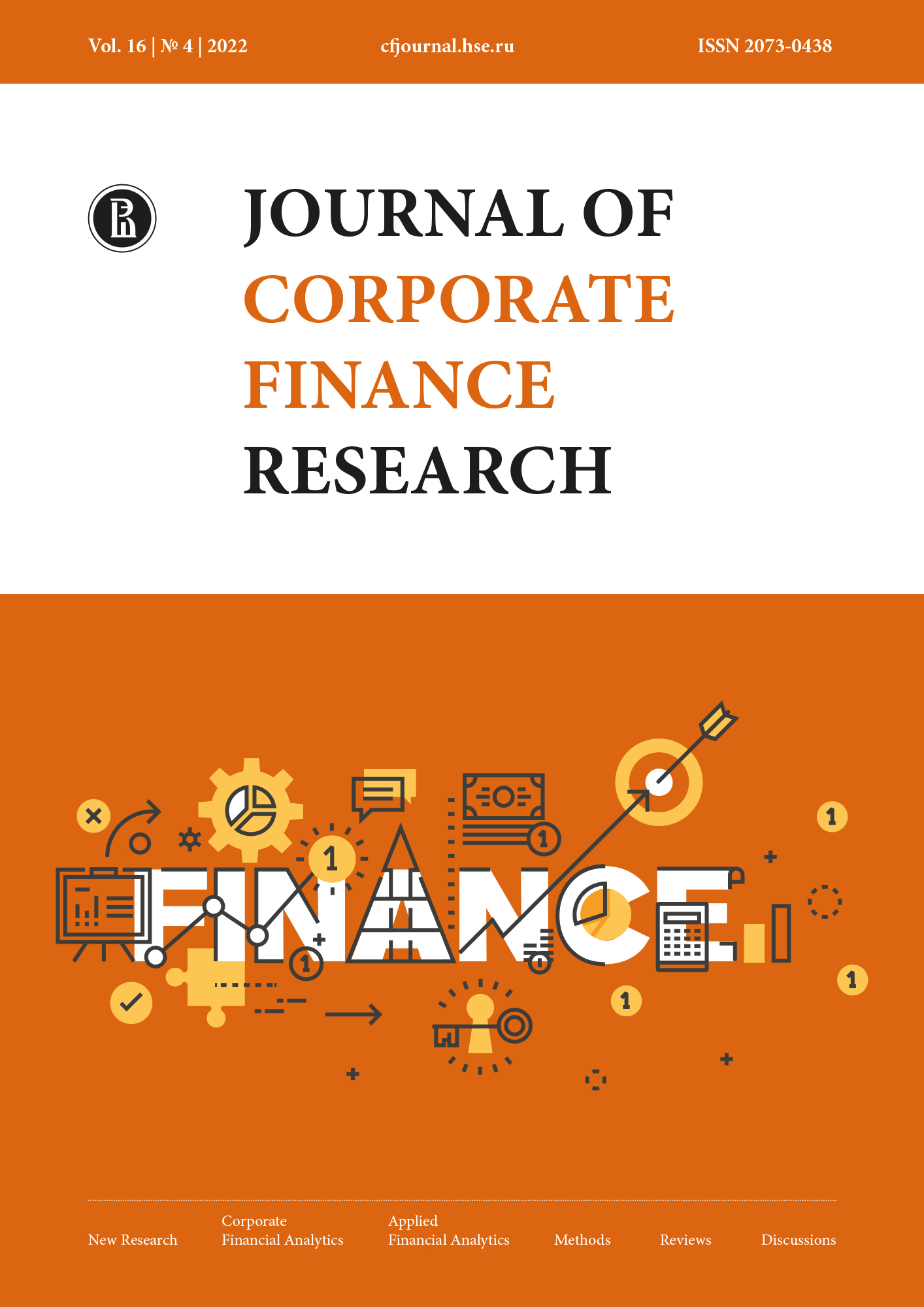Impact of CEO Overconfidence on M&A Performance in the US: A Content Analysis
Abstract
Despite the high activity on the market for corporate control, more than 60% of M&As are unsuccessful and contribute to damage to the value of the acquiring company. We still have little evidence on the impact of M&A deals in different countries and industries on shareholer value, as well as the factors that influence this impact. Academic researchers and practitioners continue to seek out the factors that influence M&A performance, but results are still inconclusive, indicating the need for further research into acquisition performance and factors that influence the overall success of M&A deals. This paper examines the impact of CEO overconfidence on the performance of M&A deals in the United States. In contrast to previous studies, we, first of all, use earnings call transcripts in content analysis as the base to measure CEO overconfi-dence; secondly, we apply cluster analysis to identify the factors that force CEOs to structure their speech during earnings calls in a similar manner; and, thirdly, we assess the impact of CEO overconfidence on the performance of high-tech deals. The study is based on a sample of 492 M&A transactions implemented during the post-crisis period, 2009–2019. Using the event study method to assess the performance of M&A deals and regression analysis, we prove that CEO overconfidence has a negative impact on the success of M&As. However, when considering a subsample of deals in which the target com-pany operates in a high-tech industry, we failed to identify a significant impact of overconfidence on M&A performance. As a result of cluster analysis, we identified a cluster of 165 companies with a common structure and similarity of CEO speeches, which are not explained by the companies’ affiliation with similar industries. This suggests that overconfident CEOs tend to use and structure their speeches similarly.
Downloads
References
Hirshleifer D., Low A., Teoh S.H. Are overconfident CEOs better innovators? The Journal of Finance. 2012;67(4):1457-1498. https://doi.org/10.1111/j.1540-6261.2012.01753.x DOI: https://doi.org/10.1111/j.1540-6261.2012.01753.x
Roll R. The hubris hypothesis of corporate takeovers. The Journal of Business. 1986;59(2):197-216. https://doi.org/10.1086/296325 DOI: https://doi.org/10.1086/296325
Malmendier U., Tate G. Who makes acquisitions? CEO overconfidence and the market’s reaction. Journal of Financial Economics. 2008;89(1):20-43. https://doi.org/10.1016/j.jfineco.2007.07.002 DOI: https://doi.org/10.1016/j.jfineco.2007.07.002
Brown R., Sarma N. CEO overconfidence, CEO dominance and corporate acquisitions. Journal of Economics and Business. 2007;59(5):358-379. https://doi.org/10.1016/j.jeconbus.2007.04.002 DOI: https://doi.org/10.1016/j.jeconbus.2007.04.002
Kolasinski A.C., Li X. Can strong boards and trading their own firm’s stock help CEOs make better decisions? Evidence from acquisitions by overconfident CEOs. Journal of Financial and Quantitative Analysis. 2013;48(4):1173-1206. https://doi.org/10.1017/S0022109013000392 DOI: https://doi.org/10.1017/S0022109013000392
Hwang Н., Kim H.-D., Kim T. The blind power: Power-led CEO overconfidence and M&A decision making. The North American Journal of Economics and Finance. 2020;52:101141. https://doi.org/10.1016/j.najef.2019.101141 DOI: https://doi.org/10.1016/j.najef.2019.101141
Ismail A., Mavis C.P. A new method for measuring CEO overconfidence: Evidence from acquisitions. International Review of Financial Analysis. 2022;79:101964. https://doi.org/10.1016/j.irfa.2021.101964 DOI: https://doi.org/10.1016/j.irfa.2021.101964
Rossi M., Yedidia Tarba S., Raviv A. Mergers and acquisitions in the hightech industry: A literature review. International Journal of Organizational Analysis. 2013;21(1):66-82. https://doi.org/10.1108/19348831311322542 DOI: https://doi.org/10.1108/19348831311322542
Langer E.J. The illusion of control. Journal of Personality and Social Psychology. 1975;32(2):311-328. https://doi.org/10.1037/0022-3514.32.2.311 DOI: https://doi.org/10.1037//0022-3514.32.2.311
Malmendier U., Tate G. CEO overconfidence and corporate investment. The Journal of Finance. 2005;60(6):2661-2700. https://doi.org/10.1111/j.1540-6261.2005.00813.x DOI: https://doi.org/10.1111/j.1540-6261.2005.00813.x
Garrard P., Rentoumi V., Lambert C., Owen D. Linguistic biomarkers of Hubris syndrome. Cortex. 2014;55:167-181. https://doi.org/10.1016/j.cortex.2013.08.014 DOI: https://doi.org/10.1016/j.cortex.2013.08.014
Merkl-Davies D.M., Brennan N.M. A conceptual framework of impression management: New insights from psychology, sociology and critical perspectives. Accounting and Business Research. 2011;41(5):415-437. https://doi.org/10.1080/00014788.2011.574222 DOI: https://doi.org/10.1080/00014788.2011.574222
Lee J.M., Hwang B.-H., Chen H. Are founder CEOs more overconfident than professional CEOs? Evidence from S&P 1500 companies. Strategic Management Journal. 2017;38(3):751-769. https://doi.org/10.1002/smj.2519 DOI: https://doi.org/10.1002/smj.2519
Craig R., Amernic J. Detecting linguistic traces of destructive narcissism at-a-distance in a CEO’s letter to shareholders. Journal of Business Ethics. 2011;101(4):563-575. https://doi.org/10.1007/s10551-011-0738-8 DOI: https://doi.org/10.1007/s10551-011-0738-8
Loughran T., Mcdonald B. When is a liability not a liability? Textual analysis, dictionaries, and 10-Ks. The Journal of Finance. 2011;66(1):35-65. https://doi.org/10.1111/j.1540-6261.2010.01625.x DOI: https://doi.org/10.1111/j.1540-6261.2010.01625.x
Loughran T., Mcdonald B. Textual analysis in accounting and finance: A survey. Journal of Accounting Research. 2016;54(4):1187-1230. https://doi.org/10.1111/1475-679X.12123 DOI: https://doi.org/10.1111/1475-679X.12123
Doukas J.A., Petmezas D. Acquisitions, overconfident managers and self-attribution bias. European Financial Management. 2007;13(3):531-577. https://doi.org/10.1111/j.1468-036X.2007.00371.x DOI: https://doi.org/10.1111/j.1468-036X.2007.00371.x
Skvortsova I., Vershinina A. Do cognitive biases impact M&A performance in emerging markets? Evidence from Russian firms. Basic Research Program Working Papers. Series: Financial Economics. WP BRP. 2021;(82). URL: https://wp.hse.ru/data/2021/05/26/1438204408/82FE2021.pdf
Masulis R.W., Wang C., Xie F. Corporate governance and acquirer returns. The Journal of Finance. 2007;62(4):1851–1889. https://doi.org/10.1111/j.1540-6261.2007.01259.x DOI: https://doi.org/10.1111/j.1540-6261.2007.01259.x
Galasso A., Simcoe T.S. CEO overconfidence and innovation. Management Science. 2011;57(8):1469-1484. https://doi.org/10.1287/mnsc.1110.1374 DOI: https://doi.org/10.1287/mnsc.1110.1374
Karnoukhova E., Stepanova A.N. Does smart & powerful CEO contribute to the performance of technology companies? Journal of Corporate Finance Research. 2019;13(4):39-58. https://doi.org/10.17323/j.jcfr.2073-0438.13.4.2019.39-58 DOI: https://doi.org/10.17323/j.jcfr.2073-0438.13.4.2019.39-58
Gubbi S.R., Aulakh P.S., Ray S., Sarkar M.B., Chittoor R. Do international acquisitions by emerging-economy firms create shareholder value? The case of Indian firms. Journal of International Business Studies. 2010;41(3):397-418. https://doi.org/10.1057/jibs.2009.47 DOI: https://doi.org/10.1057/jibs.2009.47
Weston J.F., Siu J.A, Johnson B.A. Takeovers, restructuring and corporate governance. Englewood Cliffs, NJ: Prentice-Hall; 2002. 689 p..
Kothari S.P., Warner J.B. Econometrics of event studies. In: Eckbo B.E., ed. Handbook of corporate finance: Empirical corporate finance. Vol. 1. Amsterdam: North-Holland; 2007:3-36. DOI: https://doi.org/10.1016/B978-0-444-53265-7.50015-9
Kile C.O., Phillips M.E. Using industry classification codes to sample high-technology firms: Analysis and recommendations. Journal of Accounting, Auditing & Finance. 2009;24(1):35-57. https://doi.org/10.1177/0148558X0902400104 DOI: https://doi.org/10.1177/0148558X0902400104
Craninckx K., Huyghebaert N. Large shareholders and value creation through corporate acquisitions in Europe. The identity of the controlling shareholder matters. European Management Journal. 2015;33(2):116-131. https://doi.org/10.1016/j.emj.2014.09.001 DOI: https://doi.org/10.1016/j.emj.2014.09.001
Mateev M., Andonov K. Do cross-border and domestic bidding firms perform differently? New evidence from continental Europe and the UK. Research in International Business and Finance. 2016;37:327-349. https://doi.org/10.1016/j.ribaf.2016.01.001 DOI: https://doi.org/10.1016/j.ribaf.2016.01.001
Copyright (c) 2022 National Research University Higher School of Economics

This work is licensed under a Creative Commons Attribution-NonCommercial-NoDerivatives 4.0 International License.

